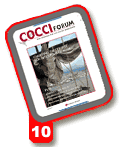COCCI People: Safety Net
Coccidiosis vaccination helps Martini Alimentare market birds with confidence and flexibility.
 Longoni: 'Food safety has to be our first priority'. |
For Dr. Corrado Longoni, choosing the right product for coccidiosis management goes beyond disease control and bird performance. Food safety is his highest priority.
"I have two babies at home," says the poultry veterinarian for Martini Alimentare, Longiano, Italy, a major poultry company located in the northeastern part of the country, about 100 km (62 miles) southeast of Bologna.
"When I go down to our company slaughterhouse to buy chicken for my family, I do it with confidence becauseI know our product is safe and free of drug residues. Food safety has to be our first priority "for us, for our customers and for the image of the poultry industry."
It's hard to argue with Longoni's
logic, but producing and marketing
residue-free poultry hasn't always been
easy "especially when using medicated
feeds to control coccidiosis.
While these treatments are
approved by regulatory authorities,
synthetic anticoccidials and ionophores "a group of feed antibiotics used routinely
for coccidiosis control "generally
have withdrawal times of at least 5
days.
In theory, that's not a big deal for a
poultry company marketing entire
houses at the same time. But for a company
like Martini, which markets 24
million birds a year at various stages in
the growth cycle, the withdrawal times
of in-feed anticoccidials can present
logistical challenges.
Thinning out broilers
In Europe, many operations start thinning
out their broiler flocks after 32
days, selling the lighter, less efficient
females at different weights "usually
1.7 to 2.4 kg (3.75 to 5.29 pounds) -
to meet the demand for smaller birds.
They retain the leaner, faster growing,
large-breasted males for chicken parts
and high-volume commercial sale later
in the production cycle.
Practically speaking, it's difficult to
withdraw feed medication from only a
portion of the flock because it would
leave other females "or, depending
on the number of feed lines, the entire
house "vulnerable to a costly coccidiosis
outbreak.
On the other hand, if the birds are
kept on medication until flocks are
thinned, there's a greater risk of birds
entering the food chain prior to the drug's withdrawal time. That can lead
to significant penalties, while damaging
the image of the company and the
poultry industry.
 Amedi: 'It's important for us to
remain flexible.'
|
"Sometimes you need more heavy birds or more lighter birds "it depends on market conditions," says Giorgio Amedei, live production manager. "That's why it's so important for us to remain flexible.
"If we used an anticoccidial in the feed, it would mean having two or three withdrawal periods, which would be very difficult to manage. To play it safe, we had to pull the anticoccidial from the feed at 30 days, which is a long time to go without coccidiosis protection."
'Can't take the risk'
Feed mill contamination is another concern when using in-feed anticoccidials. Unless the mill's lines are flushed after each usage "a process that saps extra time and labor "it's possible for drugs used in one batch to show up in feeds for other birds or other species.
"Like other producers, we need to be careful because we do not have a feed mill specifically for broiler feeds," Longoni explains. "Residues from infeed anticoccidials used in broiler feeds could be toxic to laying hens, breeders or turkeys. We can't take that risk, nor do we want traces of drugs in our withdrawal feed for broilers."
 Vandi: 'Manage the problem in
a nutritional way'
|
Martini was also concerned about
wearing out the few in-feed anticoccidials
that were still on the market. "We have only two chemicals and three
or four ionophores we can use, and we
are not sure how much longer those
products will be available," Amedei
says. "And without nicarbazin, the
ionophores are also less effective."
Martini, which is also Italy's second
largest feed company, has found a
practical solution to all of these feedrelated
concerns in poultry: coccidiosis
vaccination. By vaccinating day-old
birds in the hatchery with Paracox-5 -
some 208,000 chicks per week "the
company can forget
about using in-feed anticoccidials
altogether.
The vaccine is administered
by a specially
designed spray cabinet,
which showers up to 100
chicks at a time with the
vaccine. A red dye in the
vaccine provides a quick
visual indicator that all
chicks were vaccinated.The dye also encourages
preening among the
chicks, which helps to
ensure even better distribution
of the vaccine.
"The big difference is
that the vaccine provides
lifelong protection," Longoni says, "and
we no longer have to worry about
withdrawal times when we do our thinnings.
The vaccine has given us a lot of
flexibility without compromising performance
or profitability."
While the vaccine costs more to use
than most feed medications, the
increase is easily offset by reduced
labor in the feed mill and
greater marketing flexibility
thanks to no withdrawal
times.
"There are a lot of hidden,
indirect costs associated with
using an in-feed anticoccidial,"
says Luc Vandi,
poultry nutritionist. "For
example, you'll have some
feed in the silo with the anticoccidial
that you have to
take out and bring to another
farm. So you can't just
compare the price of the vaccine
to drugs. You have to
look at the big picture."
Going drug-free
Martini began vaccinating a portion of
its broilers in 2000, when Paracox-5
was approved for use in Europe. The
company was confident it would be a
good product because it had success
with Paracox-8 in breeders.
"But broilers are different and, obviously,
have a much shorter life cycle,"
Longoni says. "We wanted to experiment
with it first."
What started as a few experimental
trials gradually spread to entire farms.
As the company obtained more experience
with the product under different
conditions, it extended usage to other
farms.
"We had to manage a few coccidiosis
outbreaks in the beginning, but
those disappeared in the second flock,"
Longoni recalls. "In fact, we found that
the vaccine and the birds performed
better with each successive flock."
By 2003, Martini was vaccinating all of its broilers with Paracox-5, thus eliminating all in-feed anticoccidials from its program. The antibiotic growth promoter avilomycin is the only medication used today in broilers, but Martini expects to eliminate all drugs as more feed medications are removed from the market.
Focusing on management
Between vaccinating for coccidiosis
and getting ready for the expected ban
on all feed medications, Martini is
focusing more on good management
and looking for ways to naturally
improve the immunity of the birds.
"All our efforts are devoted to
young chicken management, especially
during the brooding period," Longoni
says. "We pay particular attention to
what we offer them as a daily feed, and
our nutritionist is constantly looking at
new formulas and possible alternatives
to antibiotic growth promoters."
After Martini stopped using ionophores, there was some concern that necrotic enteritis might become more prevalent, but the company has not seen any significant problems.
"We know that ionophores are very
effective against enteritis, but we can't
use them in our system," Vandi says.
"Our goal is to manage the problem in
a nutritional way, using a less concentrated
feed in the first phase to cause
less stress on the intestines and have
compensatory growth in the second
period."
For example: With animal proteins
not permitted in European feeds, soybean
meal is the only protein
source available. "The
key is to use a high quality
soybean meal," Amedei
says. "If you don't, you
have to reach an inclusion
rate in the starter diet of
40% or more, which is
concentrated but not very
digestible."
Since switching to coccidiosis
vaccination, Martini
is now in a better position
to build its feed program
around the nutritional
needs of the birds "not
the withdrawal times of
the medications. That might allow
Martini to start feeding lower cost withdrawal
feeds at an earlier phase.
"We are also assessing feed distribution,
room temperature and humidity,
ventilation, lighting, type and quality of
litter, and the water supply," Longoni
reports.
"Our goal is to make young chickens
as strong as possible with a robust
immunity that can fight stress and allow
them to reach their full genetic potential
"without having to rely on
drugs."







